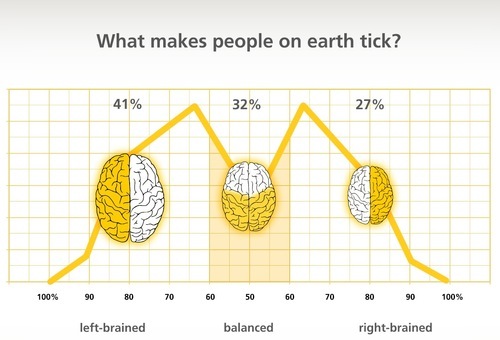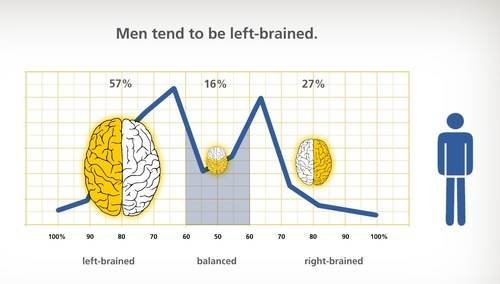My MBA mate, Leonard Sommer from the Berlin School of Creative Leadership, conducted a fascinating online research with his brother Gordon. More than 35 million people from 205 countries completed the study and put their brains to the test.
The German brothers were not trying to conduct a neuroscience study but an exciting guide to show even more exciting results for those who were genuinely interested in finding out their brain dominance through an online test.
Forty-one percent of the participants were left-brained, 27 percent right-brained and 32 percent came out balanced using both left and right hemispheres equally.
Source: Sommer+Sommer, n=35.345.657 people from 205 countries
If creativity is one of the most important resources of the future, then having almost half of the world using the left-brain hemisphere makes me wonder how to challenge ourselves.
Although both sexes were weighed equally within the study, the results could not have been more different. Among males, the left hemisphere dominated in most cases. Whereas, women tended to bridge the gap between left and right, using both emotion and reason simultaneously when making decisions.
It took the female participants an average of 58 seconds to complete the test, while the male participants took 81 seconds, and therefore, taking 39 percent more time.
As if that was not exciting enough, it was even surprising to find out that women and men reacted differently to the idea of friendship. One question in the test asked participants to identify a picture that related most to the concept of friendship. The majority of women chose an image symbolizing a one-to-one relationship, while men chose an image symbolizing a multi-network or loose grouping.
As a branding expert, I am super pleased to find such test results, because it greatly helps us when planning certain shopper decision journeys.
The 35,345,675 people came from 28,904 cities. I could not help but wonder if there were any country specifics worth finding out, so I rushed to Leonard and asked. It turned out that the Japanese were the most patient test participants since only less than 11 percent stopped before completion. Cubans were the slowest as it took them 5.15 minutes to complete the test versus South Koreans who were the fastest, with an average 2.2 completion time.
But what I am most amazed with is the time and effort that the Sommer Brothers gave for this project, and all out of pure curiosity. At the end of the day, this is what makes the world go round.
Just think about it!


